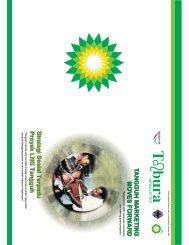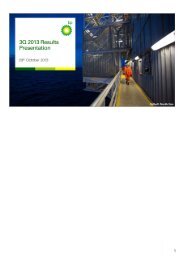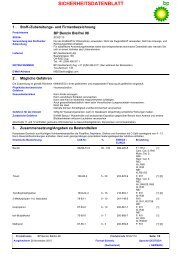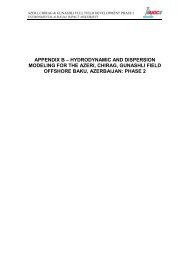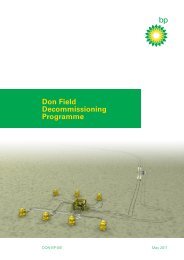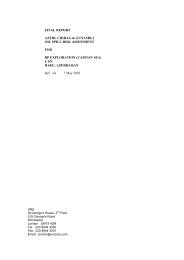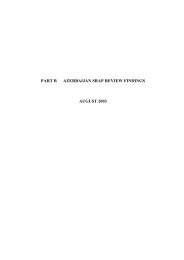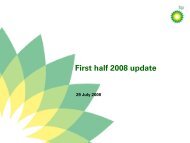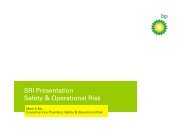Create successful ePaper yourself
Turn your PDF publications into a flip-book with our unique Google optimized e-Paper software.
“Our reputation, and, <strong>the</strong>refore, our future as a business,<br />
depends on each <strong>of</strong> us, everywhere, everyday, taking<br />
personal responsibility for <strong>the</strong> conduct <strong>of</strong> <strong>BP</strong>’s business.”<br />
Tony Hayward<br />
can be harder to spot. The cause and effect<br />
with safety is very clear; <strong>the</strong>re is a science<br />
behind it. But when faced with an ethical<br />
dilemma, <strong>the</strong> solution can sometimes cause<br />
a completely new dilemma somewhere else<br />
along <strong>the</strong> chain. “I cannot tell you <strong>the</strong><br />
number <strong>of</strong> times an OpenTalk [<strong>BP</strong>’s<br />
confidential compliance and ethics helpline]<br />
investigation has found that two or three<br />
people made a judgement that has created a<br />
non-compliant situation. Not because <strong>the</strong>y<br />
were doing anything covert, but because<br />
<strong>the</strong>y were trying to do <strong>the</strong>ir best, but made a<br />
bad judgement,” says Kuryk.<br />
To encourage employees to better<br />
understand <strong>the</strong> dilemmas and adapt<br />
accordingly, C&E has created a number <strong>of</strong><br />
tools. The two most prominent are its<br />
global OpenTalk helpline (which receives<br />
more than 1,000 calls per year) and its code<br />
<strong>of</strong> conduct, benchmarked as best-in-class.<br />
The code covers five key business areas:<br />
protection <strong>of</strong> health, safety, security and<br />
environment; employee treatment;<br />
interaction with business partners;<br />
interaction with governments and<br />
communities; and appropriate handling <strong>of</strong><br />
company assets and financial integrity. “It’s<br />
a universal standard,” says Kuryk. “If you do<br />
everything <strong>the</strong> way <strong>the</strong> code tells you to do<br />
it, you’ll be in good shape from an ethical<br />
perspective.”<br />
Simple process<br />
Of course, an 84-page document cannot<br />
cover every nuance <strong>of</strong> every instance in<br />
every part <strong>of</strong> <strong>the</strong> world. So, says Langton,<br />
<strong>the</strong> process is simple: “If <strong>the</strong>re is no local<br />
guidance in <strong>the</strong> region you work in, <strong>the</strong>n<br />
follow <strong>the</strong> code. If <strong>the</strong> local guidance is<br />
more exacting than <strong>the</strong> code, <strong>the</strong>n follow<br />
<strong>the</strong> local guidance.”<br />
Ultimately, managing compliance and<br />
ethics is about managing risk, and<br />
McCormick believes <strong>the</strong> company has<br />
come on leaps and bounds in <strong>the</strong> way it<br />
does this. “Lots <strong>of</strong> companies are good at<br />
identifying risk,” he says. “The big question<br />
<strong>the</strong>n is how you take action.”<br />
In <strong>the</strong> past, <strong>BP</strong> carried out an annual<br />
exercise in which <strong>the</strong> top 7,000 individuals<br />
in <strong>the</strong> company had to consider<br />
compliance and ethics risk and confirm<br />
<strong>the</strong>y were managing it appropriately. In<br />
2007, <strong>the</strong> team assessed <strong>the</strong> situation and<br />
came to <strong>the</strong> conclusion that it was an<br />
unwieldy process that only really asked<br />
people to list issues, with little direction on<br />
how to actually manage <strong>the</strong>m. “It was an<br />
enormous task, and <strong>the</strong> business benefit<br />
was not commensurate with <strong>the</strong> effort,”<br />
says Kuryk.<br />
It was clear that if <strong>the</strong> team wanted to<br />
ensure a high standard <strong>of</strong> compliance, <strong>the</strong>n<br />
<strong>the</strong> process needed to be simplified and <strong>the</strong><br />
conversation changed. All <strong>BP</strong>’s businesses<br />
and functions know <strong>the</strong>y need to manage<br />
<strong>the</strong>ir risks. “It is <strong>the</strong>ir decision, <strong>the</strong>ir risk,”<br />
says Langton. The role <strong>of</strong> <strong>the</strong> C&E team is<br />
to promote compliance, provide oversight<br />
and help respond to ethical quandaries.<br />
It is a collaborative effort. Ra<strong>the</strong>r than a<br />
central team disseminating a list <strong>of</strong> risks<br />
and leaving <strong>the</strong> businesses to figure it out,<br />
<strong>the</strong> process is a two-way conversation, in<br />
which <strong>the</strong> C&E team helps a business or<br />
function respond to known risks. And if<br />
<strong>the</strong> C&E team should spot ano<strong>the</strong>r issue as<br />
<strong>the</strong>y listen to a business, <strong>the</strong>n all <strong>the</strong> better.<br />
There are, <strong>of</strong> course, risks that can have<br />
an impact on any part <strong>of</strong> <strong>BP</strong>’s activities –<br />
such as bribery, breaches <strong>of</strong> competition<br />
law, environmental protection and<br />
personal conduct – but underneath <strong>the</strong>se<br />
‘top line’ <strong>the</strong>mes, <strong>the</strong>re’s a second layer <strong>of</strong><br />
more specific issues depending on which<br />
part <strong>of</strong> <strong>the</strong> business you’re focusing.<br />
“The risks have very different instances<br />
in very different parts <strong>of</strong> <strong>BP</strong>, and actually can<br />
be different in different parts <strong>of</strong> an<br />
individual segment,” says McCormick. “So,<br />
one risk could be a blanket issue right across<br />
our Exploration & Production businesses,<br />
but only relevant in one sub-segment <strong>of</strong> our<br />
Refining & Marketing operations. Our job is<br />
to make sure <strong>the</strong> programme works<br />
everywhere, while having enough flexibility<br />
to cater to all our customers.<br />
“There is a real art to understanding<br />
what is happening in <strong>the</strong> multitude <strong>of</strong><br />
different businesses in <strong>the</strong> 65 jurisdictions<br />
where <strong>BP</strong> operates. It’s very complex and<br />
it’s multi-dimensional. It’s what makes it<br />
fun – to make compliance and ethics<br />
relevant from a business standpoint.”<br />
The ultimate goal is that this joined-up<br />
approach should run like a seam right<br />
through <strong>BP</strong>’s DNA and, to ensure that <strong>BP</strong>’s<br />
board <strong>of</strong> directors plays a critical role.<br />
While many company boards review <strong>the</strong>ir<br />
compliance programme once a year, <strong>BP</strong><br />
reviews its risk pr<strong>of</strong>ile every single<br />
business quarter.<br />
Fluid situation<br />
The attention it is given is a reflection <strong>of</strong> <strong>the</strong><br />
fact that <strong>BP</strong> is dealing with a dynamic, fluid<br />
situation. “The fact that Tim’s team talks<br />
straight to <strong>the</strong> top <strong>of</strong> <strong>the</strong> line regularly<br />
means <strong>the</strong>y understand what <strong>the</strong> businesses<br />
are experiencing as it happens,” says Kuryk.<br />
“It is about being relevant on a day-inday-out<br />
basis,” adds Langton, “and it has to<br />
be simple o<strong>the</strong>rwise people won’t do it.”<br />
Simplicity allows all <strong>BP</strong> employees to<br />
take <strong>the</strong> kind <strong>of</strong> individual responsibility<br />
for <strong>the</strong> group that Hayward describes in <strong>the</strong><br />
code <strong>of</strong> conduct. In turn, it helps tell a<br />
strong story to <strong>the</strong> outside world – driving<br />
reputation. Indeed, o<strong>the</strong>r companies have<br />
approached <strong>BP</strong> to share its experiences.<br />
And, if potential partners value <strong>BP</strong>’s ethical<br />
commitment as a reason to want to work<br />
with it, <strong>the</strong>n doing <strong>the</strong> right thing brings<br />
about mutual advantage – in o<strong>the</strong>r words,<br />
good business in <strong>the</strong> ethical sense provides<br />
a multinational company with its license<br />
to continue operating. ■<br />
“There is a real art to understanding what is<br />
happening in <strong>the</strong> multitude <strong>of</strong> different businesses in<br />
<strong>the</strong> 65 jurisdictions where <strong>BP</strong> operates. It’s very<br />
complex and it’s multi-dimensional. It’s what makes<br />
it fun – to make compliance and ethics relevant from<br />
a business standpoint.”<br />
Tom McCormick<br />
<strong>BP</strong> MAGAZINE Issue 1 2009 27



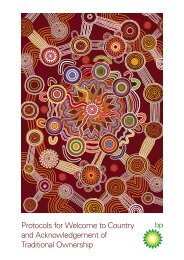
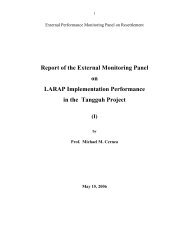
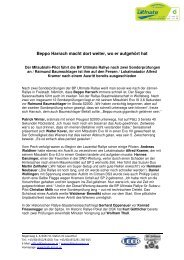
![[PDF] Deepwater Horizon: Accident Investigation Report - BP](https://img.yumpu.com/51697031/1/190x245/pdf-deepwater-horizon-accident-investigation-report-bp.jpg?quality=85)
